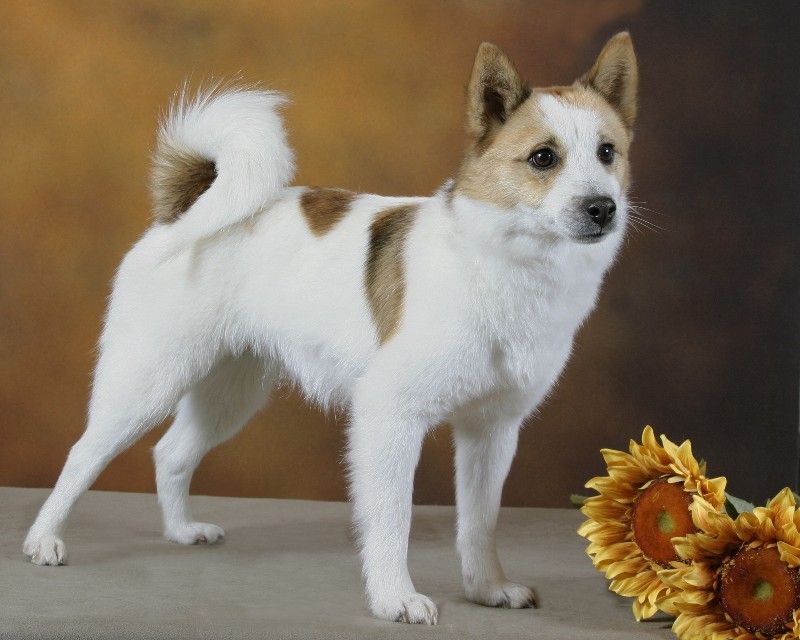The goal when grooming the Norrbottenspets; the coat should be light and stand off the dog. Should bounce and shimmer with the dog as it moves.
Let a powerful dryer help in grooming the coat, before and after the bath – blow out loose coat, tangles, dirt – dry and fluff. When finished you should be able to sink a wide-toothed comb to the skin and pull it freely out to the end of the hair shaft.
- Edge ears with thinning shears to make very natural and neat.
- Use a damp towel to go over the muzzle after the bath.
- Remove whiskers if preferred so.
- The neck and chest can really get packed with coat; pay close attention to this area.
- Thoroughly line brush and comb the entire dog.
- Neaten feet to look natural with well arched toes.
- Shave pads.
- Trim hocks.
Bathing and Drying the Norrbottenspets
Bathe your Norrbottenspets once a week to once every 12 weeks.
Use a regular, all-purpose shampoo followed by a skin conditioner, unless otherwise indicated. Sink your fingers deeply into the coat while scrubbing to do a thorough job. A rubber curry with cone-type teeth does an excellent job of helping shampoo to penetrate the longer coat.
A natural bristle scrub brush works very well on the shorter coat, especially around the feet and legs. A scrub brush works well on longer fur used with the growth of coat, such as on the rear of the dog where fecal matter may cling to the fur.
A variety of drying methods can be used starting with a vigorous hand towel drying. Follow with high velocity drying to remove excess moisture and to blow out the bulk of the loose fur, using the most powerful setting the dog will tolerate.
Make sure the high-pressure airflow does not fold the coat onto itself, causing “whip knots” that are almost impossible to remove later. To avoid “whip knots” and use the high-velocity dryer effectively, keep the airflow as close to the skin as possible but far enough away so the coat does not totally fold over onto itself.
The distance of the dryer from the coat changes with the length of the coat, i.e., closer for shorter fur, further away for longer fur. This process is tricky so pay attention to the technique.
When no moisture is being sprayed from the fur and/or no loose coat is being blown out, another drying method may be used. Some stylists continue with the high-velocity dryer, removing the condenser cone.
In that case, hold the end of the nozzle right against the skin. Work the air in a small circular fashion until the coat is dry in that area. Or, switch to natural-air drying or kennel drying using a low temperature setting.
You also may finish drying with a heat stand dryer while brushing. Whatever process or combination of processes is used, drying is not finished until the coat is completely cool and dry to the touch.
The coat of Norrbottenspets needs to have some sort of active drying method in the final stage, either high velocity or stretch drying, to produce a high quality groom job.
Pre-Work
- Trim or grind nails at least every four to six weeks to maintain a healthy foot structure.
- Clean the ears by swabbing with a mild ear cleaning solution.
- Prior to bathing, quickly go over the entire body with a high-velocity dryer to help lift dirt and dander away from the skin and loosen any shedding coat.
Brushing
Use a slicker brush, rubber curry, shedding blade, dematting tool or undercoat rake to loosen skin dander and remove loose coat.
Be careful when using any tool with metal teeth or bristles. A heavy hand or too much repetition in an area can cause cuts and/or brush burns.
Brushing and combing is not finished until all loose fur is removed, or it has become difficult to remove more than a half a brush full after repeated brushing.
Feet and Hocks
Trim the pads with a close cutting action blade, ranging from a #15 to a #40. Use a very light touch to clean the pads of long hair. If there is long fur between the toes, back brush the fur so it stands up and away from the foot.
With thinning shears, trim off the excess creating a neat and very natural looking foot with well arched toes. Tidy the outside edge of the foot, if needed, with small detailing shears.
If the hocks have longer coat on them, trim lightly with thinning shears showing a neat, clean area. A #4F blade used in reverse works well for trimming the tops of the feet and the hocks on some dogs.
Detail Finish
Removal of whiskers on the muzzle is optional, based on your preference. Finish with a fine mist of coat polish on the body for added shine. Application of bows and mild cologne is optional.
Grooming Tip:
Let your hands guide you. Learn to feel for differences in coat density levels. Areas that feel heavier or denser than other areas need special attention when bathing, brushing and drying.
Suggested Tools & Equipment
- Nail Trimmers
- Styptic Powder
- Ear Cleaning Solution
- Cotton Balls
- Clippers
- #40 and #15 Blades for Pads
- #4F for Feet and Hocks (optional)
- Slicker Brush
- Greyhound Comb
- Rubber Curry
- Carding Tool
- De-Shedding Tools
- Small Detailing Shears
- Thinning Shears
- High-Velocity Dryer

